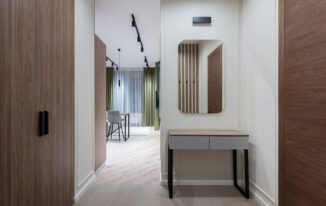Outdoor lighting can enhance the safety and security of any property. It can dissuade burglars, provide illumination to avoid slips and falls, and make it easier for residents and guests to see what they are doing after dark. If homeowners aren’t careful about their outdoor lighting choices, though, the fixtures themselves can pose a safety hazard. Read on to find some tips for how to ensure safety when installing and using outdoor lights to avoid unnecessary risks.

Tip #1: Buy Outdoor-Rated Fixtures
Not all lighting fixtures are meant to be installed outdoors, and there’s no guarantee that lights intended for indoor use will be able to withstand the elements. The outdoor-rated fixtures from Steel Lighting Co are designed to handle anything Mother Nature has to throw at them. They can be installed in damp, wet, or windy locations and will be able to withstand extreme temperature changes without posing any risks.
When choosing outdoor lighting fixtures, there are a few terms buyers can look for to make sure they’ll be up to the task. Somewhere on the packaging or product description, the fixtures will be labeled as weatherproof, weather-resistant, or suitable for wet areas. If the manufacturer doesn’t make any mention of weather ratings, stay away.
Tip #2: Use Outdoor-Rated Bulbs
Don’t stop at buying outdoor-rated fixtures. The bulbs should also be rated for outdoor use. Not all light bulbs appropriate for outdoor applications are described with language indicating that they are weather-resistant. Check the fine print on the bulbs. Appliance bulbs that can withstand the heat in an oven or the freezing cold and dampness of a residential freezer will do just fine outdoors.
Tip #3: Avoid Overlamping
Overlamping refers to the use of bulbs that exceed the maximum wattage of a light fixture. There’s a reason that manufacturers include information about maximum wattage in their product descriptions. Using bulbs with a higher wattage draw than the fixture can support will overheat its wiring, damaging the insulation.
When choosing LED light bulbs, make sure to consider the actual wattage of the bulb, not the bulb’s incandescent equivalent wattage. LEDs are very energy-efficient, so they produce more light for the same power draw as incandescent. Bulb manufacturers often offer incandescent equivalents to make it easier for homeowners to choose products with the right lumen output, but that’s not a direct analog for power draw.
Tip #4: Keep Flammable Materials Away
Most light bulbs produce heat. If there are flammable materials close to the bulbs, it can create a fire hazard. Let’s take a look at one surprisingly common example to illustrate the point.
Many families choose to install nativity scenes outside their homes during the Christmas season. These dioramas often include straw, paper, and other flammable materials. Almost every year, there’s at least one news story about nativity scenes starting house fires, often as a result of either electrical malfunctions or the heat generated from the light bulbs setting flammable materials on fire.
The same problem can occur with any flammable materials. Never install decorative paper lanterns in direct contact with outdoor bulbs, and don’t place the fixtures near flammable yard debris like hay, straw, or piles of leaves. It’s not worth the risk.
Tip #5: Install Covers for Wet or Damp Locations
Planning to install temporary lighting on a screened-in porch or out in the open? There are plenty of outdoor-rated holiday and accent lights that can be plugged into household receptacles, but these can pose a danger of their own. If the receptacle isn’t under a roof where the wind won’t blow rain and snow its way, the outlet needs to be covered when it’s not in use.
Tip #6: Have an Electrician Install GFCI Protection
Ground fault circuit interrupters (GFCIs) are designed for installation in damp areas like kitchens and bathrooms. They’re a must-have fixture for any location where people will be plugging in lights while they are grounded, which includes any time someone is plugging in a string of lights while standing in the yard.
If there’s no GFCI protection from the home’s circuit breaker or another device leading to the outdoor receptacle, it’s time to make a change. Hire an electrician to install a weather-resistant GFCI outlet before plugging in those holiday lights or installing temporary accent lighting before a party.
Tip #7: Use Outdoor-Rated Extension Cords
Planning to use temporary lights to illuminate areas far from the home? Running an extension cord might be the only viable option. It’s important to purchase outdoor-rated cords that can withstand the elements, though. Indoor extension cords aren’t designed to be exposed to moisture, let alone rain and snow. Using them outdoors can cause serious safety hazards.
Tip #8: Know When to Upgrade
Temporary lighting is great for periodic use, but these fixtures aren’t designed to stay up year-round. If homeowners want permanent lighting solutions, they should buy outdoor fixtures and hire an electrician to install them correctly. In many cases, this will require running wires for the new fixture, but it’s worth the extra time and expense. Permanent outdoor lighting fixtures are manufactured to different safety and durability standards than temporary lights. More often than not, they’ll also provide more effective illumination.
Tip #9: Don’t Be Afraid to Use Outdoor Fixtures Indoors
While it’s definitely not safe to install indoor-rated lighting fixtures outside, it’s perfectly fine to use outdoor fixtures inside. In many cases, it can even be beneficial. Outdoor lighting is designed to withstand severe weather, so it will hold up incredibly well to anything it could be faced with inside the home, including excessive moisture or temperature swings. Traditional outdoor fixtures can also add some extra visual appeal to farmhouse-style homes.
The Bottom Line
A good outdoor lighting plan will improve the safety, security, usability, and curb appeal of any home, but it’s important to take some safety precautions. As long as homeowners purchase fixtures and bulbs for outdoor use from reputable vendors and inform themselves about how to use them safely, they’ll have nothing to worry about. The sky is the limit when it comes to designing creative outdoor lighting plans.



